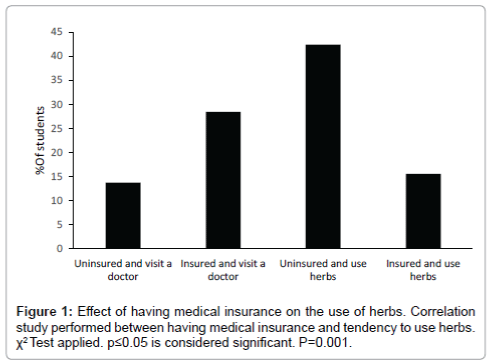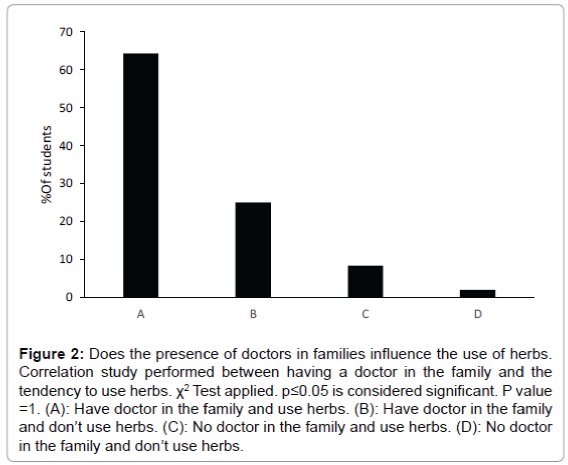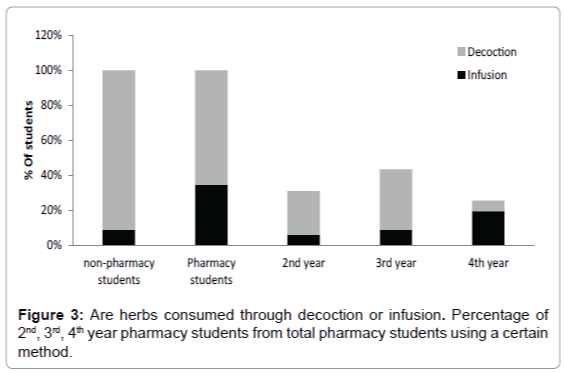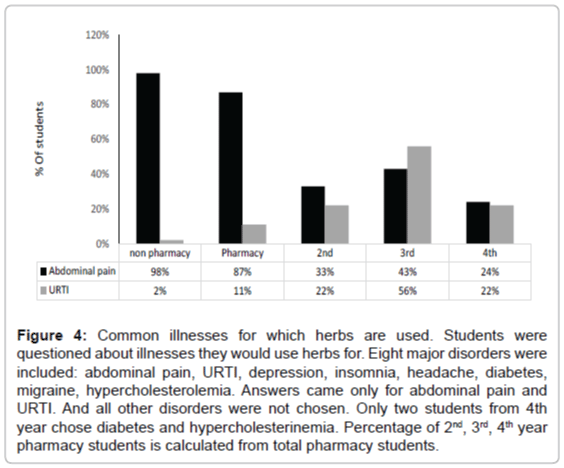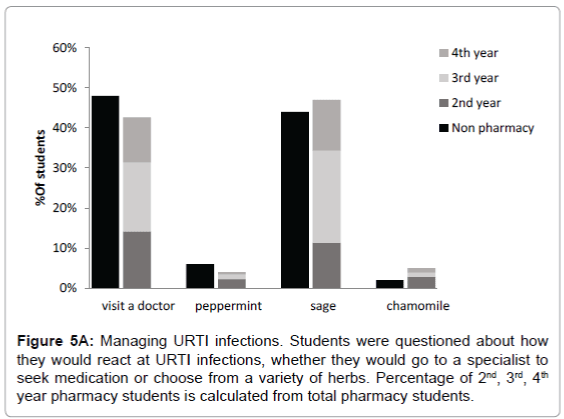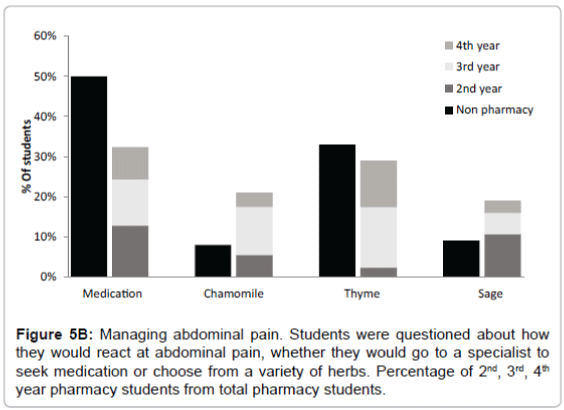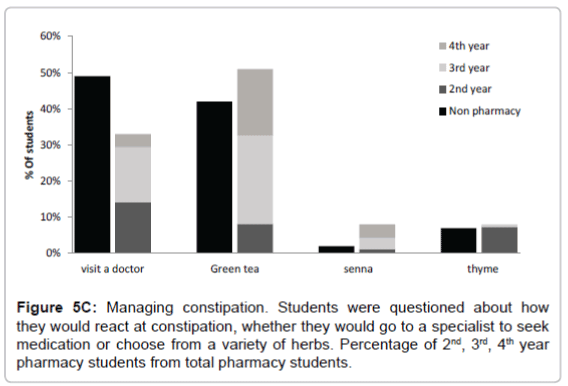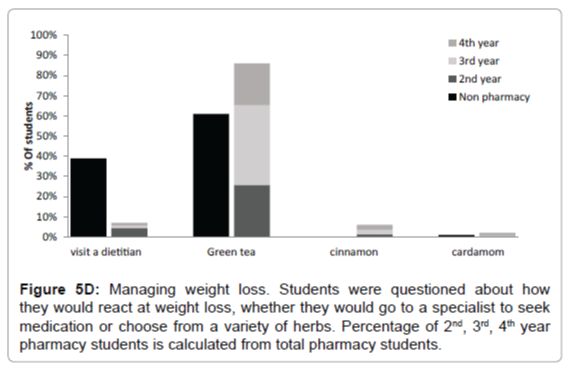Research Article Open Access
Perceptions and Use of Medicinal Herbs among College Students at a Jordanian University in Amman-Jordan: Traditions Supersedes Education
Abdelmalek SMA*, Alkhawaja B and Darwish DA
Department of Pharmacology and Biomedical Sciences, University of Petra, Amman, Jordan
- *Corresponding Author:
- Abdelmalek SMA
Department of Pharmacology and Biomedical Sciences
The Faculty of Pharmacy and Medical Sciences, University of Petra
Amman, Jordan
Tel: 00962-795511248
E-mail: sabdelmalek@uop.edu.jo
Received date: August 26, 2016; Accepted date: September 07, 2016; Published date: September 13, 2016
Citation: Abdelmalek SMA, Alkhawaja B, Darwish DA (2016) Perceptions and Use of Medicinal Herbs among College Students at a Jordanian University in Amman-Jordan: Traditions Supersedes Education. J Tradi Med Clin Natur 5:191.
Copyright: © 2016 Abdelmalek SMA, et al. This is an open-access article distributed under the terms of the Creative Commons Attribution License, which permits unrestricted use, distribution, and reproduction in any medium, provided the original author and source are credited.
Visit for more related articles at Journal of Traditional Medicine & Clinical Naturopathy
Abstract
Herbs serve as valuable remedies in many cultures. They offer an alternative to increasingly ineffective drugs. This study assesses the perceptions and determinants of medicinal herbs use among students at University of Petra, Amman, Jordan. A cross-sectional study involving randomly selected students from pharmacy and non-pharmacy specialties is conducted based on self-administered questionnaire. The sample involved 350 students (168 pharmacy and 182 nonpharmacy students). Medicinal herbs use as an alternative to medication is reported by 80% of pharmacy and 65% of non-pharmacy students. Sixty three percent of all students prefer using medicinal herbs over visiting a physician, as it is perceived easier and safer by 63% and 35% of pharmacy and 65% and 30% of non-pharmacy students, respectively. Lack of medical insurance significantly encouraged herbal use (p<0.001). Major sources of information on medicinal herbs use included family as reported by 71% of non-pharmacy and university education (53%) as reported by pharmacy students, however, 33% of pharmacy students reported family to be their major source of information of which 76% of them were second year students who were not yet exposed to education about herbs. Wrong choice and preparation of herbs are noted in 91% of non-pharmacy and 63% of pharmacy students. Abdominal pain is the primary reason for using medicinal herbs as reported by 98% and 87% of non-pharmacy and pharmacy students, respectively. Followed by upper respiratory tract infections (URTI), reported by 11% of pharmacy and 2% of non-pharmacy students. One per cent of pharmacy students who were in their fourth year mentioned diabetes and hypercholesterolemia as ailments that can be treated by herbs. None of the participants chose depression, insomnia, headache or migraine as an indication for which medicinal herbs can be used. The use of medicinal herbs among students is prevalent. It is primarily influenced by culture, however, further guidance to avoid faults in herbal choice and preparation is demanded.
Keywords
Medicinal herbs; College students; Traditions; Jordan
Introduction
Herbs are a valuable source of remedies in many cultures worldwide. Human beings used herbs for culinary as well as curative purposes for several thousand years [1]. Herbal medicine is a popular branch of alternative medicine. It offers an alternative to the increasingly ineffective drugs. According to the World Health Organization (WHO) more than three-quarters of the world’s population rely on traditional medicine, mainly medicinal herbs [2]. Arabs are no exception to this; they used herbal medicine long time ago. In fact, the traditional Arabic and Islamic medicine is based on the use of a single plant or a mixture of plants to treat diseases [2]. Medicinal herbs fall under the category of traditional nutraceuticals that have been used in prevention and treatment of several non-infectious (e.g., diabetes [3], depression [4], insomnia [5] and dyslipidemia [6]) as well as infectious diseases [7]. Their action is fundamental when considering patients who are intolerant to certain medications [6].
In the international setting, use of herbs was investigated among various populations; young and elderly. In the Middle East, many studies discussed use of medicinal herbs among adult populations [1,8-11]. Nonetheless, little is known about herbs use among college students in this region of the world. Being a wide societal segment, it is important to understand college students’ health patterns and practices. They are young, active and more approving of new approaches to health care [12,13]. Besides, students can play a significant role in the spread of health-related information to the society particularly if they will become members of the medical field.
In the Arab world, however, strong connections between family members prevail. Siblings are adherent to their families and show respect to their ancestors’ experiences [14]. This led to the assumption that herbal use among Arab students would be influenced by their families. The current study is set to assess the awareness, perceptions and use of medicinal herbs among students at University of Petra, Amman, Jordan. It also aims at identifying factors that impact use of herbs, and examines the assumption that cultural beliefs and ancestors’ advice have a greater influence over students’ herbal use practices compared to education.
Materials and Methods
A cross-sectional self-administered questionnaire-based survey was conducted between October 2009 and January 2010. The study proposal was reviewed and approved by the Scientific Research Council at the University of Petra.
The sample involved university students from pharmacy and non-pharmacy faculties, namely; the faculties of Arts and Science and Information technology, at the University of Petra-Amman, Jordan. Pharmacy students were randomly enrolled from second, third and fourth year levels. This was intended in order to reflect the impact of education on herbs use, as the pharmacy program includes three academic courses on herbs introduced at the third year level. These courses are a pharmacognosy course, that introduces students to medicinal herbs, their constituents, methods of collection, drying, preparation, and preservation, as well as uses, and two phytochemistry courses (1&2), that focuses on the biosynthesis and the chemical and physiochemical properties of the principal classes of natural mixtures used in therapy.
The students were invited to participate in the study and verbal consent was sought before handing in the questionnaires, confidentiality and anonymity of the results were assured. To organize the process of questionnaire distribution and prevent overlap or repetition, questionnaires were given simultaneously to all students attending lectures from 9 to 10 am and collected at the end of the lecture.
The questionnaire was constructed upon reviewing relevant literature. It was field-tested to assure its applicability and comprehensiveness. The questionnaire was primarily written in English, and then translated into Arabic; the mother tongue spoken in Jordan. Translation was validated by a fluent speaker of both languages. The questionnaire comprised of 26 questions, which enquired about students’ demography, specialty and year of study, medical insurance status and having a physician in the family. It also asked about relatives’ use of herbs and whether herbs were used for culinary or medicinal purposes. Sources of information about medicinal herbs were investigated by giving students the choices of family, physicians, university education, or media (television, radio, newspaper) to choose from. Moreover, it explored the use of herbs as an alternative to drug therapy, as a prophylaxis versus treatment, and as self- directed therapy versus visiting a doctor. Also students’ knowledge of the proper uses of certain herbs in the management of common diseases was explored. This was by providing a list of commonly used herbs in the local setting (e.g., chamomile, thyme, sage, mint, green tea, cinnamon, cardamom and senna) and diseases (e.g., upper respiratory tract infections, abdominal pain, constipation, weight loss, insomnia, headache, and diabetes) to match. The method of preparation of herbs (infusion versus decoction) and whether any education was received in this regard were also investigated.
Data handling and statistical analysis
Data were entered onto and analyzed for frequencies using Microsoft Office Excel 2013. Statistical significance calculated using χ2 test on SPSS. Significance was defined as a p value ≤ 0.05. Missing data were omitted from the analysis, which were believed to be minimal.
Results
Sample demography
Three hundred and fifty students participated in this study. The sample consisted of two groups; pharmacy students (n=168) and non-pharmacy students (n=182). Pharmacy students were distributed as 53 (31.5%), 73 (43.5%), and 42 (25%) in second, third and fourth year levels, respectively. More than half of sample have no medical insurance. Both student groups were similar in terms of having a doctor in the family (Table 1).
| Variable | Number of students [%] |
|---|---|
| Specialty | |
| Pharmacy | 168 [48] |
| Non-pharmacy | 182 [52] |
| Total | 350 [100] |
| Insurance status | |
| Insured | 150 [44] |
| Uninsured | 192 [56] |
| Total | 342 [98] |
| Number of students with a doctor in the family | |
| Pharmacy | 149 [89] |
| Non-pharmacy | 163 [90] |
| Total | 312 [89] |
Table 1: Demography of the study sample.
Use of medicinal herbs among college students: A majority of all students (82% of both pharmacy and non-pharmacy students) kept herbs at home (Table 2), they did so for culinary purposes over remedy. Third year pharmacy students constituted the majority of pharmacy students who kept herbs at home whether for cooking (n=48,44) or for treatment purposes (n=25, 43%). They were followed by second year then fourth year students (Table 3).
| Pharmacy students | Non-pharmacy students | Total % | |
|---|---|---|---|
| Do you keep herbs at home? | 137 [81.5] | 149 [81.9] | 286 [81.7] |
| Reason for keeping herbs at home | |||
| Cooking | 110 [65] | 154 [85] | 264 [75] |
| Remedy | 58 [35] | 28 [15] | 68[19] |
| Does any member of your family use herbs? | 120 [71] | 141 [77.5 | 261 [75] |
| Did you ever use herbs as an alternative to medicine | 134 [80] | 118 [65] | 252 [72] |
| Do you use herbs for: | |||
| Prophylaxis | 60 [36] | 66 [36] | 126 [36] |
| Treatment | 108 [64] | 116 [64] | 224 [64] |
| If you exhibit symptoms of disease, you: | |||
| Self-medicate with herbs | 106 [63] | 114 [63] | 220 [63] |
| Visit a physician | 62 [37] | 68 [37] | 130 [37] |
| Why do you prefer using herbs over going to the doctor when ill | |||
| Safer | 59 [35] | 55 [30] | 114 [33] |
| Easier | 106 [63] | 118 [65] | 224 [64] |
| Lower cost | 3 [2] | 9 [5] | 12 [3] |
*Only yes answers are recorded.
Table 2: Perceptions* and use of medicinal herbs among the study sample.
| Pharmacy Students N [%] | ||||
|---|---|---|---|---|
| Study year | 2nd | 3rd | 4th | Total |
| You keep herbs at home for: | ||||
| Cooking | 34 [31] | 48 [44] | 28 [25] | 110 |
| Treatment | 18 [31] | 25 [43] | 15 [26] | 58 |
| You use herbs for: | ||||
| Prophylaxis | 19 [31] | 26 [43] | 15 [26] | 60 |
| Treatment | 33 [31] | 48 [44] | 27 [25] | 108 |
| You prefer to use herbs over visiting a physician when you feel ill because it is: | ||||
| Safer | 13 [22] | 29 [49] | 17 [29] | 59 |
| Easier | 38 [36] | 42 [40] | 25 [24] | 106 |
| Less cost | 1 [25] | 2 [50] | 1 [25] | 4 |
Table 3: The use of Medicinal herbs by pharmacy students as classified by study year.
Eighty percent of pharmacy and sixty five percent of non-pharmacy students stated that they used herbs as an alternative to medication. Sixty four percent of pharmacy and non-pharmacy students used herbs for treatment rather than prophylaxis purposes (Table 2). However,variations existed among pharmacy students at different study years in terms of intention behind using herbs (Table 3). Moreover, selfmedication with herbs is practiced by 63% of all students over visiting a doctor when feeling ill. This was similar between both pharmacy and non-pharmacy students (Table 2).
Determinants of using medicinal herbs: Insurance status was found to be inversely correlated with the use of medicinal herbs. Uninsured students reported a significantly higher level of herbal use (p<0.001) compared to insured ones (Figure 1). Insurance also significantly (p<0.001) determined the tendency of students to visit doctors for treatment. 28.4% have insurance and go to the doctor versus 13.7% don’t have insurance and go to the doctor.
Other factors which rendered self-medicating with herbs preferred over visiting a doctor included primarily easiness of herbs use (63% of pharmacy and 65% of non-pharmacy), and a perceived safety of herbs compared to drugs by 35% of pharmacy and 30% of non-pharmacy students. The relatively low cost of medicinal herbs, on the other hand, did not impact choosing them over visiting a doctor in both groups (Table 2). A majority of pharmacy (71%) and non-pharmacy (77%) students had a family member that used medicinal herbs at some time. Almost 90% of pharmacy and non-pharmacy students had a doctor in their families (Table 1). Nonetheless, the presence of a doctor in the family did not have a significant impact on controlling use of herbs (P=1) instead of medicine, since 64.4% of these students used herbs. Oppositely, 25% of those who did not have a doctor in their families also used herbs (Figure 2).
Figure 2: Does the presence of doctors in families influence the use of herbs. Correlation study performed between having a doctor in the family and the tendency to use herbs. χ2 Test applied. p≤0.05 is considered significant. P value =1. (A): Have doctor in the family and use herbs. (B): Have doctor in the family and don’t use herbs. (C): No doctor in the family and use herbs. (D): No doctor in the family and don’t use herbs.
Sources of information on medicinal herbs: Eighty one percent of pharmacy students acknowledged receiving education about medicinal herbs whereas 75% of non-pharmacy students gave a negative answer. Sources of information among both student groups differed, where university education on herbs was the major source of information for pharmacy students (53%), this was not applicable to non-pharmacy students who received no education about herbs at university (Table 4). A majority of pharmacy students who indicated university education as a source of information were in third year (63%) compared to 37% who were fourth year students (Table 4). Non-pharmacy students (71%) considered family the primary source of information about herbs, and 29% obtained their information from television. However, 33% of pharmacy students considered family as a source of information on this matter those were mainly second year students (76%) (Table 4).
| Pharmacy students % | Non-pharmacy students% | |||||
|---|---|---|---|---|---|---|
| Did you receive any education about herbs | Yes | No | Yes | No | ||
| 81 | 19 | 25 | 75 | |||
| Sources of information on herbs* | 2nd† | 3rd† | 4th† | total | Non-pharmacy | |
| University education | 0 | 63 | 37 | 53 | 0 | |
| Family | 76 | 15 | 9 | 33 | 71 | |
| TV | 48 | 33 | 19 | 13 | 29 | |
| Magazine | 0 | 67 | 33 | 2 | 0 | |
| Did Physicians ask about use of herbs | Yes | No | Yes | No | ||
| 74 | 26 | 66 | 34 | |||
*Participant could choose more than one of the listed sources of information.
†2nd, 3rd, 4th: Study year.
Table 4: Sources of student information on medicinal herbs.
Physicians were not considered as a source of information on medicinal herbs by any of the sample. Seventy percent of students who visited doctors stated that even when physicians asked about herbal use they did not provide relevant advice nor education.
Preparation of medicinal herbs: A majority of non-pharmacy and pharmacy students, 91% and 65%, respectively, prepared herbs by decoction (boiling) (Figure 3). Among pharmacy students third year students were the most to apply decoction (53%), whereas fourth year students were the least to use it (9%). On the other hand, infusion was applied by 39% of pharmacy students, most of which were fourth year students. This latter method was used by only 9% of non-pharmacy students (Figure 3).
Use of medicinal herbs to treat common illnesses: Abdominal pain is the major reason for which herbs were used as reported by 98% and 87% of non-pharmacy and pharmacy students, respectively. This is followed by upper respiratory tract infections (URTI), reported by 11% of pharmacy and 2% of non-pharmacy students (Figure 4). Most of the pharmacy students who used herbs to treat abdominal pain and URTI were in their third year level (Figure 4). In the management of URTI, 50% of non-pharmacy and 32% of pharmacy students preferred using medication over medicinal herbs (Figure 5A). The majority of pharmacy students who preferred using medication were in their second year level. The rest of pharmacy students who used herbs (68%), listed a variety of medicinal herbs, namely thyme, chamomile and sage (Figure 5A). Thyme was the herb chosen by most pharmacy and non-pharmacy students to manage URTI (Figure 5A). As for abdominal pain, 48% of nonpharmacy and 43% of pharmacy students preferred visiting a doctor over using medicinal herbs. Sage was the primary herb used for abdominal pain by both groups (Figure 5B). Constipation was managed in 42% of nonpharmacy and 51% of pharmacy students by drinking green tea, a minority used thyme (almost 10% of both groups), those were mainly either second year pharmacy or non-pharmacy students. Senna was used to a lesser extent, mainly by fourth year pharmacy students (Figure 5C). As for weight loss, green tea was the primary herb used by 86% of pharmacy students (46% in third year level) and 61% of non-pharmacy students (Figure 5D). One percent of pharmacy students who were in their year mentioned diabetes and hypercholesterolemia as ailments that can be treated by herbs. None of the participants chose depression, insomnia, headache or migraine as an indication for which medicinal herbs can be used.
Figure 4: Common illnesses for which herbs are used. Students were questioned about illnesses they would use herbs for. Eight major disorders were included: abdominal pain, URTI, depression, insomnia, headache, diabetes, migraine, hypercholesterolemia. Answers came only for abdominal pain and URTI. And all other disorders were not chosen. Only two students from 4th year chose diabetes and hypercholesterinemia. Percentage of 2nd, 3rd, 4th year pharmacy students is calculated from total pharmacy students.
Discussion
Use of medicinal herbs is prevalent between college students in this study, which complied with a previous Jordanian study [15]. Our assumption that students’ use of medicinal herbs is positively affected by their families proved to be valid. Yet, a major determinant that affected herbal use, whenever provided, was education. A proof of this is the resemblance in responses between second year pharmacy and nonpharmacy students. Being not yet exposed to herbs-relevant academic courses at their second year of study rendered them depending on their families to obtain information about herbs. Whereas third year pharmacy students showed more awareness of the medicinal uses of herbs, their prophylactic and treatment effects compared to second and fourth year students. However, when it comes to the handling of herbs, education didn’t seem to correct faulty cultural believes. It is known that herbs containing volatile oils decompose and/or lose activity if exposed to high temperatures for long periods [16]. Having the majority of students in this study boiling herbs before use revealed unawareness of proper preparation.
The indications for medicinal herbs reported herein were much fewer than those named in other studies [14,17]. While most participants in this study agreed that herbs are mainly used for abdominal pain and URTI, participants in a similar study carried in the USA indicated that the most frequent conditions for which herbs are used, musculoskeletal conditions, stomach or intestinal illnesses, anxiety/depression, insomnia, severe headache or migraine, menopause, cholesterol, and recurring pain [17]. This reflected the unawareness of the current study population of the potential uses of herbs. In fact, having a minority of pharmacy students acknowledging the role of herbs in the management of diabetes and dyslipidemia indicated substantial unawareness of medicinal herbs use. The choice of correct medicinal herb in treating some common illnesses constituted another challenge to non-pharmacy and pharmacy students. The use of sage for respiratory conditions is an incorrect practice. Sage is mainly indicated in cases of fever, digestive disorders and stomachache [18]. Similarly, the use of thyme to treat constipation is a suboptimal practice, as senna proved to be more effective [19].
It was interesting to note that the presence of a physician in a family did not affect the use of herbs. This could be explained by the lack of physician input into patients’ education on the use of herbs as shown in the results. The literature showed how health care professionals, among which physicians, could play an important role in raising public’s awareness on the proper use of herbs in treating diseases [20].
Also, of worth reporting is the tendency of pharmacy students in this study not to apply the information gained from the academic courses taught. This was clearly reflected by the responses of fourth year pharmacy students, which posed a question on how effective were the academic courses provided to them.
Despite the proven benefits from using medicinal herbs, the potential harm associated with their use should be emphasized [21], having a majority of students preferring the use of herbs, because they believed they were safe, is a prevalent misconception. In fact, there is an increasing concern about the safety of some medicinal herbs. Accidental herbal toxicity occurs not only as a result of lack of quality control over harvesting and preparing herbs, but also due to the false belief they are harmless [21].
Lack of insurance and the low income per capita evident in Jordan supported the use of herbs. This was further endorsed by the fact that those who had medical insurance reported using medicine over herbs to treat illnesses.
Study Limitations
Limitations to the study are those expected with self-administered surveys, first, where students might have over or under reported their use of herbs. Second, the fact that there are too many herbs sold in the market used for a wide array of indications and not all of them were listed in our study. However, we chose the most popular ones that are believed to be known by everyone regardless of their background and used for very common illnesses.
Conclusion
The use of medicinal herbs among students is prevalent. The influence of traditional beliefs on use of herbs is substantial. However, whenever education is provided it does shape practices relevant to herbs. Yet gaps in the awareness of the potential uses of herbs and their proper preparation are evident. More relevant education and hands-on practice are required to fill these gaps.
References
- Abu Rabia A (2005) Herbs as a food and medicine source in Palestine. Asian Pacific J Cancer Prev 6:404-407
- Azaizeh H, Saad B, Cooper E, Said O (2010) Traditional Arabic and Islamic medicine, a re-emerging health aid. Evid Based Complement Alternat Med 7:419-424.
- Rizvi SI, Mishra N (2013) Traditional Indian medicines used for the management of Diabetes Mellitus. J Diabetes Res 2013
- Basti AA, Moshiri E, Noorbala AA, Jamshidi AH, Abbasi SH et al. (2007) Comparison of petal of Crocus sativus L and fluoxetine in the treatment of depressed outpatients: a pilot double-blind randomized trial. Prog Neuropsychopharmacol Biol Psychiatry31:439-442
- Wing YK (2001) Herbal treatment of insomnia. Hong Kong Med J7:392-402
- Scicchitano P, Cameli M, Maiello M, Modesti PA, Muiesan ML, et al. (2014) Nutraceuticals and dyslipidaemia: Beyond the common therapeutics.J Funct Foods 6:11-32
- Ewam UP (2014) Evidence based antibacterial potentials of medicinal plants and herbs countering bacterial pathogens especially in the era of emerging drug resistance: An integrated update. Int J Pharmacol10:1-43
- Afifi FU, Abu-Irmaileh B (2000) Herbal medicine in Jordan with special emphasis on less commonly used medicinal herbs. J Ethnopharmacol72:101-110
- AbuIrmaileh BE, Afifi FU (2003) Herbal medicine in Jordan with special emphasis on commonly used herbs. J Ethnopharmacol 89:193-197
- Alzweiri M, Al Sarhan A, Mansi K, Hudaib M, Aburjai T (2011) ethnopharmacological survey of medicinal herbs in Jordan, the Northern Badia region. J Ethnopharmacol 137:27-35.
- Wazaify M, Afifi FU, El-Khateeb M, Ajlouni K (2011) Complementary and alternative medicine use among Jordanian patients with diabetes. Complement Ther Clin Pract17:71-75.
- Rogers EM (1995) Diffusion of Innovations (4th edn.) ACM The Free Press
- Dwairy M (2003) Validation of multigenerational interconnectedness scale among Arab adolescents. Psychol Rep93:697-704
- Johnson SK, Blanchard A (2006) Alternative medicine and herbal use among university students. J Am Coll Health Assoc55:163-168
- Khader Y, Sawair FA, Ayoub A, Ayoub N, Burgan SZ, et al. (2008) Knowledge and attitudes of lay public, pharmacists, and physicians toward the use of herbal products in North Jordan. J Altern Complement Med14:1186-1187
- Turek C, Stintzing FC (2013) Stability of essential oils: a review. Compr Rev Food Sci Food Saf 12:40-53
- Gardiner P, Graham R, Legedza AT, Ahn AC (2007) Factors associated with herbal therapy use by adults in the United States. Altern Ther Health Med13:22-29
- Lima CF, Andrade PB, Seabra RM, FernandesFM, Pereira WC (2005) The drinking of a Salvia officinalis infusion improves liver antioxidant status in mice and rats. J Ethnopharmacol97:383-389
- Kinnunen O, Winblad I, Koistinen P, Salokannel J (1993) Safety and efficacy of a bulk laxative containing senna versus lactulose in the treatment of chronic constipation in geriatric patients. Pharmacology47:253-255
- Bauer BA (2000) Herbal therapy: what a clinician needs to know to counsel patients effectively. Mayo Clinic Proceedings
- Saad B, Azaizeh H, Abu-Hijleh G, Said O (2006) Safety of traditional Arab herbal medicine. Evid Based Complement Alternat Med3:433-439
Relevant Topics
- Acupuncture Therapy
- Advances in Naturopathic Treatment
- African Traditional Medicine
- Australian Traditional Medicine
- Chinese Acupuncture
- Chinese Medicine
- Clinical Naturopathic Medicine
- Clinical Naturopathy
- Herbal Medicines
- Holistic Cancer Treatment
- Holistic health
- Holistic Nutrition
- Homeopathic Medicine
- Homeopathic Remedies
- Japanese Traditional Medicine
- Korean Traditional Medicine
- Natural Remedies
- Naturopathic Medicine
- Naturopathic Practioner Communications
- Naturopathy
- Naturopathy Clinic Management
- Traditional Asian Medicine
- Traditional medicine
- Traditional Plant Medicine
- UK naturopathy
Recommended Journals
Article Tools
Article Usage
- Total views: 13237
- [From(publication date):
November-2016 - Nov 21, 2024] - Breakdown by view type
- HTML page views : 12360
- PDF downloads : 877

